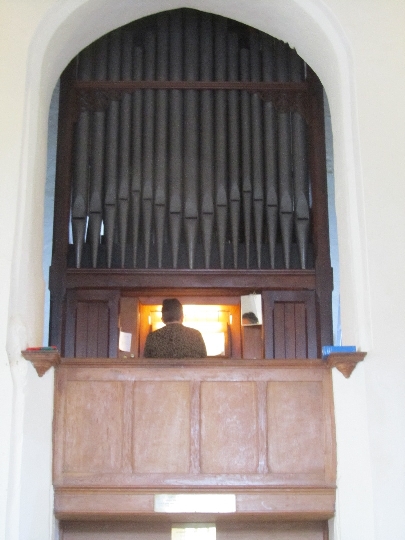The Organ

The organ now in the loft at the west end, of the church, came from the Chapel of St Luke in the Radcliffe Infirmary, Oxford.
The Radcliffe Chapel was consecrated in 1867 with music provided by a harmonium. Records from 1867 show a chapel organ being insured for £100 and in 1884 £1.12.0 (£1.60) was paid for repairs. Minutes of the weekly Board Meeting held on 25th March 1891 record "the committee sanctioned the thorough cleaning and repairing of the Chapel organ at the cost of £25, for which Mr G M Holdich of London furnished an estimate." Sadly the works journals of G M Holdich for 1867 are missing but it was probably then that the organ was installed - probably it was second-hand since it has been dated as being built cl850 and when Walkers carried out work on the organ in 1968 George's initials were found on the bellows weights.
After 1891 there is little recorded about the organ until H Mears worked on the action in 1947. In 1968 Walkers carried out a restoration with modifications to the mechanical action, a balanced swell pedal was added and a humidifier installed; more recently £3,000 was paid to Nicholsons in 1978 for renovation of the wind chests.
Griffiths & Cooper removed the organ from the Radcliffe in 2007 and took it to their workshops on the Isle of Wight for repair and storage. Many of the metal pipes were splitting as a result of 100 years of cone-tuning and a decision was made to repair the tops and fit tuning slides. Some of the long feet were in poor condition and these too were repaired and made good. At some point a schwimmer had been added and the decision was made to put back what had probably been in the original organ - a double-rise bellows. When the organ was taken out it was found that the 'case' in fact only covered the 2 visible sides, front and left. The craftsmen at G&C have made an exact copy of the side casework so that now both sides are safely enclosed. Perhaps more remarkably, they have removed many layers of green gloss paint to reveal the original polished wood at the front and side of the organ.
The three year project was under the guidance of the Organ Consultant, Dr William McVicker.

Joanna playing the'Stacey' G M Holdich Organ
The Organ Builder
George Maydwell Holdich was born at Maidwell Hall in Derbyshire on 14th August 1816, the fourth son of the Reverend Thomas Holdich and his second wife, Elizabeth Laura Maydwell.
Having served an apprenticeship with the organ builder James Bishop, in 1837 George started his own business, occupying premises in Bishops Wall, Lambeth. For the next 57 years he stayed working in London, moving to Soho, then up to the area around King's Cross. When George retired in 1894, the business was sold to Eustace Ingram, who in turn sold it on after a short time to Gray & Davison.
During his career, George built over 400 organs. Most were small single or two manual instruments for village churches but he also built a few larger organs - most notably for Lichfield Cathedral in 1861. As well as building for the UK market, George also exported organs to Australia, New Zealand and Jerusalem.
Holdich organs had a deserved reputation for being well-constructed and George was also innovative, introducing a new type of octave-coupler called a Diaocton. Over 50 Holdich organs are still being played today and they are particularly noted for their fine tonal qualities. Several, including this organ now installed in Sidlesham, have been awarded Historic Organ Certificates by the British Institute of Organ Studies.
George Holdich died on 30th July 1896 in Forest Hill, London.